3D Sensor Market Research, 2031
The global 3d sensor market was valued at $17.6 billion in 2021, and is projected to reach $57 billion by 2031, growing at a CAGR of 13% from 2022 to 2031. 3D sensor technology is one of the active technologies that is suitable for a variety of applications, such as automotive, healthcare, consumer electronics, manufacturing, and others.
The introduction of 3D depth-sensing technology in consumer devices has been gradual during the last ten years. The technology's first commercial use was noted in the field of gaming. In the realm of 3D imaging and detection, 3D depth-sensing technology has recently expanded. One of the major elements influencing the expanding use of 3D sensing technology is the capability of mobile devices to take 3D images rather than 2D ones.
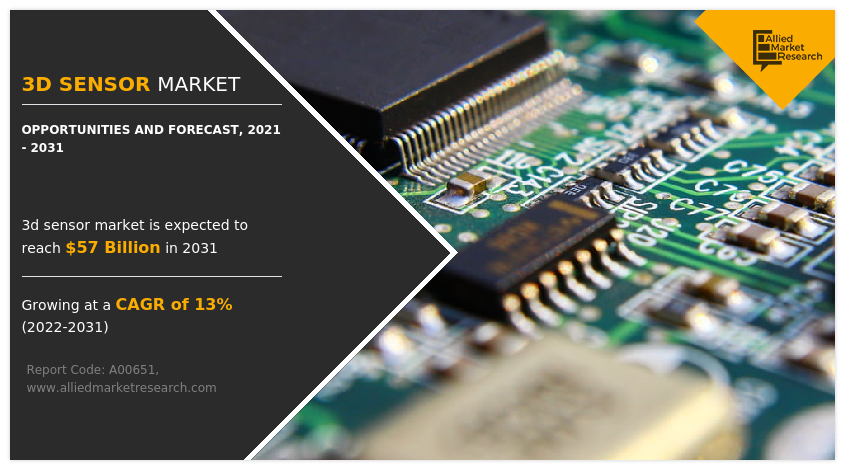
The 3D sensor industry has gained traction as a result of increased smartphone demand, where consumer electronics hold the largest pie share. One of the most crucial features in mobile communications is the ability to unlock the phone using 3D facial recognition instead of a fingerprint or PIN. It may soon become necessary for mobile payment apps and mobile IDs, as it makes authentication more convenient and safer. Healthcare, automotive, aerospace, and military are the major verticals in terms of 3D imaging use, which offer a variety of benefits for inspection applications. These are some of the factors that are projected to drive the 3D sensor market size over the projected period.
Factors, including a lack of product differentiation, rising maintenance costs, and sectors with little experience in device manufacturing, can all hinder market growth. The cost of manufacturing 3D sensors is substantial. Additionally, the technologies that are employed to create these sensors are not as advanced as the product itself. This manufacturing process disturbance can lead to the creation of faulty or unreliable sensors, which might slow the market's expansion.
Also, there are a lot of concerns with images taken using low-megapixel cameras. When these photographs are cropped, enlarged, or printed, the image quality is affected. Consequently, there is an increase in demand for high-megapixel cameras. To increase the number of pixels, manufacturers must either expand the chip size or reduce the pixel pitch. As a greater chip size costs more, the only method to create a picture with a high resolution and at a cheap cost is to reduce the pixel pitch, which is a difficult and expensive procedure. Typically, a smaller photo-sensing area emerges from a smaller pixel pitch, which has an impact on the performance of the image. The market for image sensors is being hampered as a result.
There are benefits to several primary technologies advancing 3D sensing. To create these new systems, high-quality sensors and effective algorithms that can take advantage of both current and emerging technology must be developed. For instance, edge-emitting laser diodes or LEDs can be replaced with vertical-cavity surface-emitting lasers (VCSELs), which are easy to use, have a restricted spectrum, and have a steady temperature. VCSELs are also replacing existing light source technologies for 3D sensing. Three methods for 3D sensing are stereoscopic vision, structured light patterns, and time of flight. These factors are accounting for the growth of the 3D sensor market opportunity.
The global 3D sensor market is segmented based on type, technology, connectivity, end-use, and region. By type, the market is sub-segmented into image sensors, accelerometer sensors, position sensors, and others. By technology, the market is classified into structured light, time of flight, stereoscopic vision, ultrasound, and others. By connectivity, the market is classified into wireless and wired. By end use, the market is classified into consumer electronics, healthcare, aerospace & defense, automotive, and others. By region, the market is analyzed across North America, Europe, Asia-Pacific, and LAMEA.
Segment Overview
The 3d sensor market is segmented into Type, Technology, Connectivity, and End use.
By type, the image sensor sub-segment dominated the market in 2021. In standalone or integrated digital cameras and imaging equipment, image sensors are a common component. It goes without saying that when light enters a camera's lens, the image sensor captures that light, turns it into an electrical signal, and then sends that signal to the imaging device processor, which converts the signal into a digital image. In addition, it is anticipated that they will have a significant impact on the size of the market for 3D sensors.
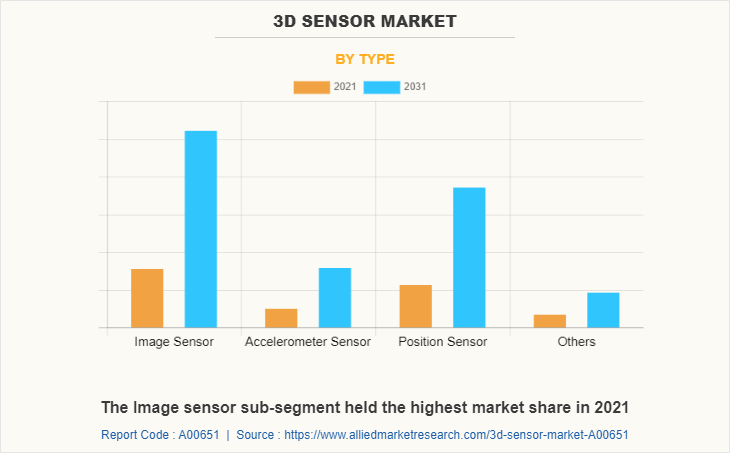
By technology, the structured light sub-segment dominated the global 3D market share in 2021. The capturing unit for stationary 3D scanners must be installed on a solid surface. An automated rotary turntable can be added to a 3D scanner to speed up the scanning process, so the user does not have to physically turn the object to scan it from all angles. Only what the cameras can see can be captured in three dimensions by a structured-light 3D scanner. Therefore, numerous scans from various angles are required to build a digital model of the complete object. To generate a comprehensive digital model, the scans are then cleaned up, combined, and sewn together.
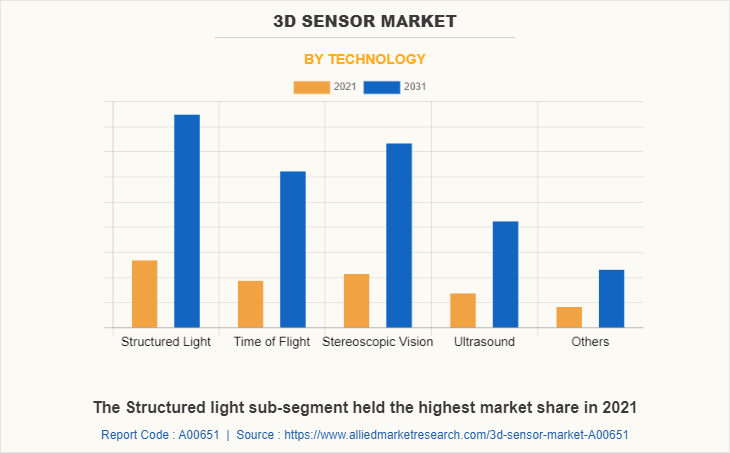
By connectivity, the wireless sub-segment dominated the global 3D market share in 2021. Self-configured and infrastructure-free 3D wireless networks are employed to cooperatively transmit data from environmental or physical elements, such as temperature, sound, vibration, pressure, motion, or pollutants, to a focal point or sink for inspection and analysis. Base stations or sinks act as an interface between users and the network. One can obtain the network-required data by injecting queries and retrieving results from the sink. Millions of sensor nodes make up a 3D wireless sensor network in most cases.
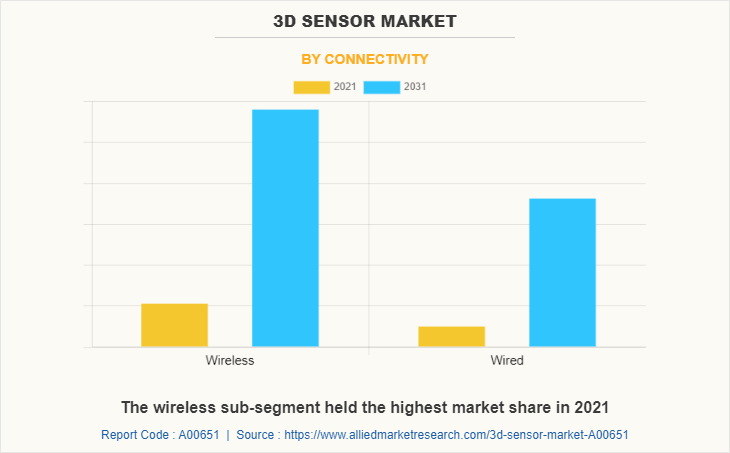
By end use, the consumer electronics sub-segment dominated the global 3D sensor market share in 2021. 3D sensors are commonly used in consumer devices, including laptops, smartphones, and televisions. All smartphone makers are attempting to use 3D sensing technology for facial recognition, gaming, and other applications. In the medical field, 3D sensors are used to view veins, cancers, and the inner layers of skin. In the automotive sector, 3D sensors are frequently employed to detect danger and traffic to prevent accidents. Along with the usage of nanotechnology, wearable technology also includes 3D sensors. As breakthroughs are made in electronics, automotive, and other industries, the use of 3D sensors will expand. Thus, the growing use of 3D sensors in various industry verticals is anticipated to drive the 3D sensor market growth in the next few years.
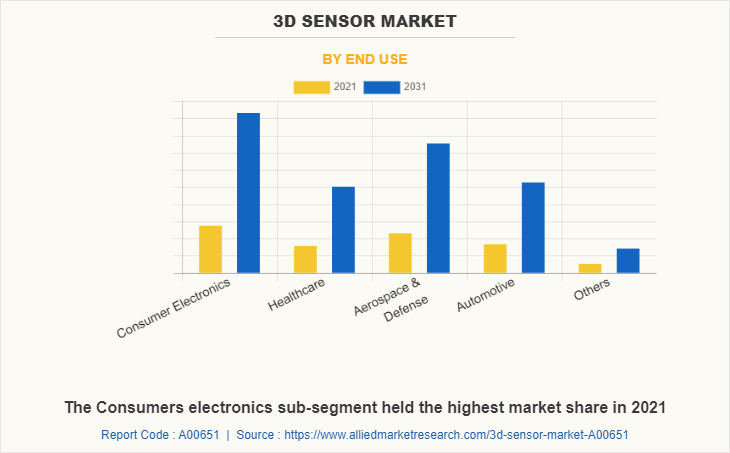
By region, North America dominated the global market in 2021 and is projected to remain the fastest-growing sub-segment during the forecast period. The consumer electronics and automotive industries, both of which have been adopting 3D sensors for a range of applications, are expected to make a significant demand for 3D sensors, making the U.S. the largest and fastest-expanding market in North America. The iPhone, a local player, is also significantly contributing to the increase in demand for smartphones in the U.S. This is expected to boost the 3D sensor industry market as well.
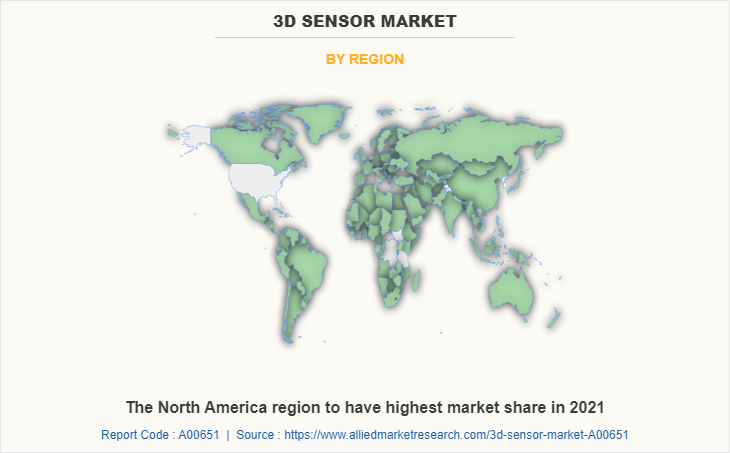
The key players profiled in this report include PMDtechnologies AG, Infineon Technologies AG, SAMSUNG, LMI TECHNOLOGIES INC., COGNEX CORPORATION, Microchip Technology Inc., Occipital, Inc., Qualcomm Technologies, Inc., KEYENCE CORPORATION, and OmniVision Technologies, Inc.
Key Benefits For Stakeholders
- This report provides a quantitative analysis of the 3D sensor market forecast, segments, estimations, and dynamics of the 3d sensor market from 2021 to 2031 to identify the prevailing 3D sensor market opportunity.
- Market research is offered along with information related to key drivers, restraints, and opportunities.
- Porter's five forces analysis highlights the potency of buyers and suppliers to enable stakeholders to make profit-oriented business decisions and strengthen their supplier-buyer network.
- In-depth analysis of the 3D sensor market segmentation helps determine the prevailing market opportunities.
- Major countries in each region are mapped according to their revenue contribution to the global market.
- Market player positioning facilitates benchmarking and provides a clear understanding of the present position of the market players, along with the 3D sensor market outlook.
- The report includes the analysis of the regional as well as global 3d sensor market trends, key players, market segments, application areas, and market growth strategies.
- The report also provides an in-depth analysis of the 3D sensor market opportunity over the forecasted timeframe.
3D Sensor Market Report Highlights
| Aspects | Details |
| Market Size By 2031 | USD 57 billion |
| Growth Rate | CAGR of 13% |
| Forecast period | 2021 - 2031 |
| Report Pages | 360 |
| By Type |
|
| By Technology |
|
| By Connectivity |
|
| By End use |
|
| By Region |
|
| Key Market Players | Occipital Inc., Omnivision Technologies, Infineon Technologies, Cognex Corporation, PrimeSense, Pmdtechnologies GmbH, SoftKinetic, LMI Technologies, IFM Electronic |
Analyst Review
The 3D Sensor Market is expected to grow at a significant CAGR throughout the forecast period, driven by rising demand for consumer electronics such as digital cameras and smartphones. These products are being upgraded with new technological features like gesture control and facial recognition, which will impel the demand for 3D sensors in the coming years. These features require a 360-degree view of the surroundings to provide accurate results, resulting in high demand for 3D sensors. These sensors, which can measure the three dimensions of an object using reflected light, create a 3D image. This reflected light is used to calculate an estimate of the correct positioning of the object, increasing their integration into cameras and mobile phones.
The market is being further stimulated by the usage of 3D sensors in augmented reality, mapping, and biometric sensors. Additionally, the complexity of 3D sensors, high maintenance costs, and subpar manufacturing could restrain market expansion. The reliable mechanical 3D sensor has been expanded with the introduction of the digital 3D sensor. The increasing popularity of augmented reality and virtual reality in gaming is providing enormous potential prospects in the worldwide 3D sensor industry.
Among the analyzed regions, North America is expected to account for the highest revenue in the market by the end of 2031, followed by Asia-Pacific, Europe, and LAMEA. Initiatives by the government to deploy 3D surveillance systems to detect suspicious activity or to capture images of speeding vehicles are propelling the regional market growth. The growing demand for security systems in homes across the world is driving up the demand for 3D sensors.
The two main factors driving the market for 3D sensors are the rise in consumer electronics demand and the application of 3D sensors in the automotive sector. In addition, the global market for 3D sensors is experiencing rapid expansion due to the rising popularity of augmented reality and virtual reality in video games.
The growing end-use industry of 3D sensors in the production of consumer electronics and in the automotive industry is anticipated to boost the 3D sensor market in the upcoming years.
The major growth strategies adopted by 3D sensor market players are product development and joint venture.
The North America is the largest regional market for 3D Sensor market.
The major players in the 3D sensor market are pmdtechnologies ag, Infineon Technologies AG, SAMSUNG, LMI TECHNOLOGIES INC., COGNEX CORPORATION, Microchip Technology Inc., Occipital, Inc., Qualcomm Technologies, Inc., KEYENCE CORPORATION, and OmniVision Technologies, Inc.
Loading Table Of Content...



